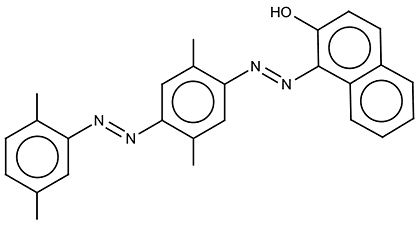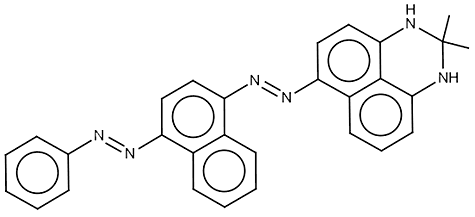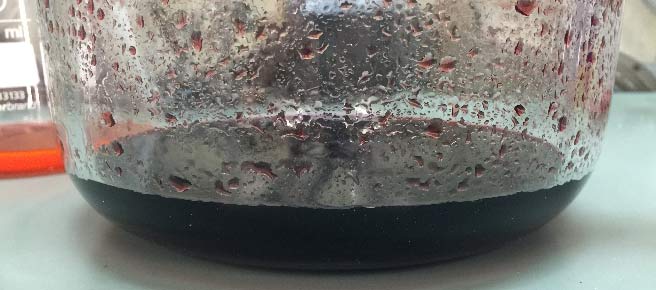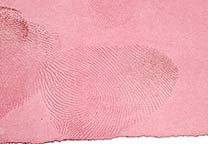History
Oil Red O (ORO) is a (non-fluorescerent) red dye used in histology for the staining of lipids in tissue samples (an often used recipe is based on a saturated solution of ORO in 60% isopropanol [1].) Oil Red O belongs to the Sudan class of dyes (a type of azo dyes, for the chemical stucture of Oil Red O and Sudan Black B see the tab "Chemical information".)
It's use for visualizing fingerprints on paper was described for the first time by the Canadian Alexandre Beaudoin in 2004 [2]. The basic (NaOH) methanol/water solution of Oil Red O he described is now known in the forensic world as the reagent "Oil Red O". Since the dye Oil Red O has a strong affinity for lipids that are not easily dissolved in water, it's use is for papers that have been wet (been outside or in wet garbage for example). Amino acid reagents are then not useful any more. PD is a reagent that is often used in that case although certainly not exclusively for this purpose.
In a later article [3] Alexandre Beaudoin and Anissa Rawji compared Oil Red O to Physical Developer (PD) and found it to work well. The usefulness of ORO was later corroborated by Australian researchers [4]. However, they found that with prints older than about 4 weeks ORO started to become less effective than PD. Probably, the lipids that ORO targets disappear or are transformed over time. It is known that PD is not working well on fresh prints.
The Australian researchers found that ORO can be used succesfully after paper has been treated with amino acid reagents like IND, DFO, and ninhydrin. They recommended to use ORO in sequence before PD.
An evaluation by American researchers [5] concluded that ORO is efficient in the processing of porous items that have been wet and can be processed within 30 days.
Directions for use
Items are treated in trays filled with a layer of ORO solution. The trays are like those used for Physical Developer (or e.g. Pyrex baking dishes.) The papers should stay immersed for a long time: 1 to 1.5 hours. The fingerprints then show up red against a pink background coloration of the paper. Glossy papers can be a problem with this reagent: the glossy layer can be attacked by the sodium hydroxide in the working solution.
After the treatment the dish is either emptied by pouring off the working solution or the papers are taken out in another dish. Since the ORO working solution is quite basic, the papers should be neutralized. For this the phosphate buffer is used. Rinsing the paper in the phosphate buffer or first in water and then with buffer (could be diluted in that case) will restore the paper to a neutral pH. Then the papers are rinsed once again but now with water (to remove any residual salts from the phosphate buffer) and dried.
References and footnotes
[1] Lillie, R.D.; Ashburn, L.L., "Supersaturated solutions of fat stains in dilute isopropanol for demonstration of acute fatty degeneration not shown by Herxheimer's technique.", Archives of Pathology, 1943, Vol. 36, p. 432.
[2] Beaudoin, "A. New technique for revealing latent fingerprints on wet, porous surfaces: Oil Red O.", Journal of Forensic Identification, 2004, Vol. 54, No. 4, pp. 413-421.
[3] Rawji, A.; Beaudoin, A., "Oil Red O Versus Physical Developer on Wet Papers: A Comparative Study", Journal of Forensic Identification, 2006, Vol. 56, No. 1, pp. 33-54.
[4] Salama, J.; Aumeer-Donovan, S.; Lennard, C.; Roux, C., "Evaluation of the Fingermark Reagent Oil Red O as a Possible Replacement for Physical Developer", Journal of Forensic Identification, 2008, Vol. 58, No. 2, pp. 203-237.
[5] Honig, M.; Yoak, J., "Oil Red O: A Comparative Performance Study", Journal of Forensic Identification, 2016, Vol. 66, No. 2, pp. 118-135.

Name: Oil Red O, 1-[{4-[(2,5-Dimethylphenyl)diazenyl]-2,5-dimethylphenyl}diazenyl]-2-naphthol
CAS-No.: 1320-06-5
Oil Red O is an azo dye (like Sudan Black B) and is also known as C.I. Solvent Red 27
Oil Red O is a "Sudan" type of dye. Compare it's structure to that of Sudan Black B:

Name: Sudan Black B










